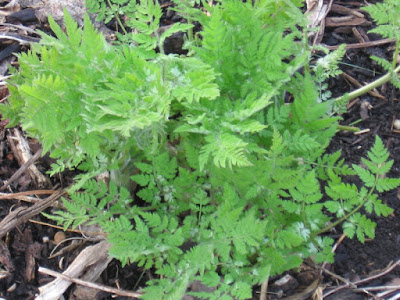

Sweet cicely: The edible leaves and seed pods of this
shade-happy perennial taste like licorice

Edible primrose flowers also love shade

The chives are coming up so fast we can almost see them grow
Tonight, dinner was a pureed potato-leek-chard-sorrel soup, a recipe I found in my "Healthy Slow Cooker" cookbook, and one worth making again. I had dug the last overwintered leeks from the garden (protected by straw) a few weeks ago. The chard was the last of leafy greens from the freezer. The vegetable stock was also the last jar. The sorrel, on the other hand, is just coming into its own in the herb bed outside the south-facing kitchen door. Each year, we have talked about using more of it; I was glad to find a simple recipe perfect for these still-chilly spring evenings that used fresh food at its peak. For dessert, we ate the last container of rhubarb-strawberry compote. I also finished the last handful of blueberries at breakfast.
The large chest freezer in our "mud room" is now almost empty; the last two bags of pole beans, packages of meat, and a few odds and ends all fit in the small kitchen freezer above the frig. There's something satisfying about finishing off the treats of last season, just as this year's crops are ready to pick. It signals a clear cycle that is often lost in what Barbara Kingsolver (Animal, Vegetable, Miracle) called the U.S.'s "promiscuous, anything anytime" food culture. There will be more blueberries, strawberries, and peaches all in their time, and not too far off either. But first, we have the sorrel, and dandelion greens and sweet cicely to savor.




